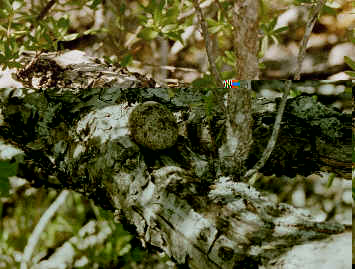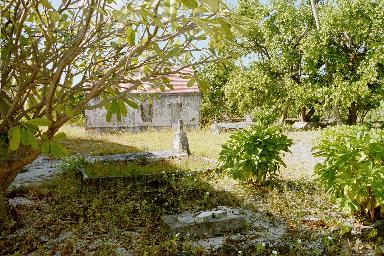| Of the hundreds of atolls and motus that make up the Tuamotus, we visited four;
Raroia, Makemo, Tahanea, and Fakarava on our way through the archipelago to Tahiti. |
| Raroia is an atoll about 25 miles long and 10 miles wide.
This is the atoll where the raft Kon Tiki made landfall in 1947 on its voyage from Peru.
The raft was almost destroyed when it landed on the eastside reef but eventually it was
rescued and transported back to a museum in Norway. People in the village still remember
the event and especially one of the crew who decided to stay. They even name some of their
children after 'Danielsson'. Five years ago pearl oysters were
brought to the Raroia to start a black pearl industry and now the local economy is based
on pearl harvesting as well as copra (coconut oil for soap and cosmetics) and soursop (a
fruit which is used for medicinal purposes locally known as nono). |
 |
|
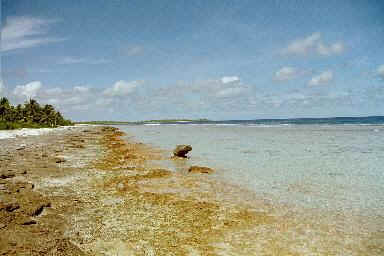 |
We spent a couple days anchored on the west side
of the atoll close to the village. There is a 'main street' which is defined by the street
lights with solar panels to collect the electricity during the day to power them at night.
Otherwise the street is a dirt lane.
The village is tidy and the houses, built in concrete, are whitewashed and
obviously taken care of. There is little water for gardens, because all water is caught
and saved in cisterns, yet some people manage to grow papaya trees and flowering shrubs.
The church is a pretty white building, always open, with the altar, cross, and lectern
decorated with pearl shells. The inner part of the pearl shell, when polished, is a
beautiful silver colour with turquoise, purple and green highlights.There is an elementary
school on the island but high school children are sent to the large central school on the
atoll of Makemo. |
|
| The east side of the atoll is made up of motus, small
islands perched on the fringing reef. We anchored behind a motu in company with ASTROLABE,
GRAY HAWK, PHANTOM, IMANI, TRIUMPH and SCALDIS. Anchoring behind
a motu protects us from the prevailing easterly winds. Unfortunately this atoll has an
overabundance of black tipped reef sharks and lemon sharks so we didn't snorkel as much as
we would have liked. After five days at Raroia we were on our way again, overnight, to Makemo. |
The winds were light, but that was fine for an overnight
passage to Makemo, only 80 miles away. We wanted to arrive at the Makemo pass around 0800
in the morning to catch an incoming current with a rising tide.
Makemo is a more developed island with about 300 people, lots of scooters and some
trucks and cars, a large church, two stores, a bakery, the local boarding school for
secondary students and (amazingly!) internet access at the post office. The
prevailing winds are from the east and the villages tend to be on the west side of the
atolls (because that is where the largest motus, the most coconut trees and the best
protection from the sea but for us at anchor it is best to be on the east side behind the
reef where there is no fetch across a lagoon creating waves. |
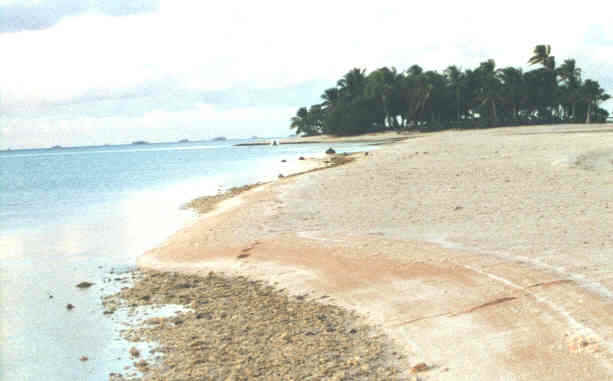 |
|
| We crossed the lagoon in the afternoon to have the sun at our
stern to make seeing the coral heads easier. The two motus just visible from the village
are joined by a sandy beach on the inside of the coral reef and give quite good protection
from both wind and waves.. |
| The weather deteriorated and we had continuous rain squalls and
fairly strong winds for a couple of days.. Finally the weather improved and C'EST
ASSEZ and ION crossed over, followed by KOOKABURRA
and FIO OKO and the following day TRIUMPH and SKIMMER.
Together we explored the reef, keeping an eye out for black tipped sharks, we forded the
many of the shallows reaching into the middle of the reef from the lagoon. |
|
| In the evenings we often built a campfire on the nearby motu and
shared pot luck finger foods, barbecued fish and told cruising stories. We watched the
sunsets and moonrises, watched the hermit crabs attracted by the smell of roasting coconut
creep slowly towards the flames, shared recipes for the various hors d'oeuvres, shucked
and cracked open coconuts for the water and meat. |
| After a week in these idyllic surroundings we decided to move up
the atoll and on our way visited a pearl farm with friends aboard TRIUMPH.
We exchanged gifts with the family and now have some pearls to add to our souvenir
collection. Another several days of snorkeling, fishing, and partying in the evenings
before leaving for Tahanea. |
|
|



